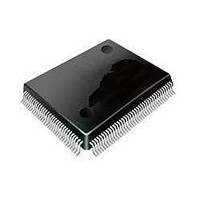ST92F120V1Q7 STMicroelectronics, ST92F120V1Q7 Datasheet - Page 167

ST92F120V1Q7
Manufacturer Part Number
ST92F120V1Q7
Description
Microcontrollers (MCU) Flash 128K SPI/I2C
Manufacturer
STMicroelectronics
Datasheet
1.ST92F120V9Q7.pdf
(325 pages)
Specifications of ST92F120V1Q7
Data Bus Width
8 bit, 16 bit
Program Memory Type
Flash
Program Memory Size
128 KB
Data Ram Size
4 KB
Interface Type
I2C, SPI
Maximum Clock Frequency
24 MHz
Number Of Programmable I/os
77
Number Of Timers
5
Maximum Operating Temperature
+ 105 C
Mounting Style
SMD/SMT
Package / Case
PQFP-100
Minimum Operating Temperature
- 40 C
On-chip Adc
8 bit, 16 Channel
Lead Free Status / Rohs Status
No
Available stocks
Company
Part Number
Manufacturer
Quantity
Price
Company:
Part Number:
ST92F120V1Q7
Manufacturer:
ST
Quantity:
6 765
Part Number:
ST92F120V1Q7
Manufacturer:
ST
Quantity:
20 000
Part Number:
ST92F120V1Q7C
Manufacturer:
ST
Quantity:
20 000
Company:
Part Number:
ST92F120V1Q7DTR
Manufacturer:
MAXIM
Quantity:
2 854
- Current page: 167 of 325
- Download datasheet (3Mb)
MULTIFUNCTION TIMER (Cont’d)
Figure 87. Pointer Mapping for Register to
Register Transfers
10.4.5.4 DMA Transaction Priorities
Each Timer DMA transaction is a 16-bit operation,
therefore two bytes must be transferred sequen-
tially, by means of two DMA transfers. In order to
speed up each word transfer, the second byte
transfer is executed by automatically forcing the
peripheral priority to the highest level (000), re-
gardless of the previously set level. It is then re-
stored to its original value after executing the
transfer. Thus, once a request is being serviced,
its hardware priority is kept at the highest level re-
gardless of the other Timer internal sources, i.e.
once a Comp0 request is being serviced, it main-
tains a higher priority, even if a Capt0 request oc-
curs between the two byte transfers.
Register File
8 bit Counter
8 bit Addr Pointer
8 bit Counter
8 bit Addr Pointer
XXXXXX11
XXXXXX10
XXXXXX01
XXXXXX00
Compare 0
Capture 0
10.4.5.5 DMA Swap Mode
After a complete data table transfer, the transac-
tion counter is reset and an End Of Block (EOB)
condition occurs, the block transfer is completed.
The End Of Block Interrupt routine must at this
point reload both address and counter pointers of
the channel referred to by the End Of Block inter-
rupt source, if the application requires a continu-
ous high speed data flow. This procedure causes
speed limitations because of the time required for
the reload routine.
The SWAP feature overcomes this drawback, al-
lowing high speed continuous transfers. Bit 2 of
the DMA Counter Pointer Register (DCPR) and of
the DMA Address Pointer Register (DAPR), tog-
gles after every End Of Block condition, alternately
providing odd and even address (D2-D7) for the
pair of pointers, thus pointing to an updated pair,
after a block has been completely transferred. This
allows the User to update or read the first block
and to update the pointer values while the second
is being transferred. These two toggle bits are soft-
ware writable and readable, mapped in DCPR bit 2
for the CM0 channel, and in DAPR bit 2 for the
CP0 channel (though a DMA event on a channel,
in Swap mode, modifies a field in DAPR and
DCPR common to both channels, the DAPR/
DCPR content used in the transfer is always the bit
related to the correct channel).
SWAP mode can be enabled by the SWEN bit in
the IDCR Register.
WARNING : Enabling SWAP mode affects both
channels (CM0 and CP0).
MULTIFUNCTION TIMER (MFT)
167/324
9
Related parts for ST92F120V1Q7
Image
Part Number
Description
Manufacturer
Datasheet
Request
R

Part Number:
Description:
8/16-bit Flash Mcu Family With Ram, Eeprom And J1850 Blpd
Manufacturer:
STMicroelectronics
Datasheet:

Part Number:
Description:
STMicroelectronics [RIPPLE-CARRY BINARY COUNTER/DIVIDERS]
Manufacturer:
STMicroelectronics
Datasheet:

Part Number:
Description:
STMicroelectronics [LIQUID-CRYSTAL DISPLAY DRIVERS]
Manufacturer:
STMicroelectronics
Datasheet:

Part Number:
Description:
BOARD EVAL FOR MEMS SENSORS
Manufacturer:
STMicroelectronics
Datasheet:

Part Number:
Description:
NPN TRANSISTOR POWER MODULE
Manufacturer:
STMicroelectronics
Datasheet:

Part Number:
Description:
TURBOSWITCH ULTRA-FAST HIGH VOLTAGE DIODE
Manufacturer:
STMicroelectronics
Datasheet:

Part Number:
Description:
Manufacturer:
STMicroelectronics
Datasheet:

Part Number:
Description:
DIODE / SCR MODULE
Manufacturer:
STMicroelectronics
Datasheet:

Part Number:
Description:
DIODE / SCR MODULE
Manufacturer:
STMicroelectronics
Datasheet:

Part Number:
Description:
Search -----> STE16N100
Manufacturer:
STMicroelectronics
Datasheet:

Part Number:
Description:
Search ---> STE53NA50
Manufacturer:
STMicroelectronics
Datasheet:

Part Number:
Description:
NPN Transistor Power Module
Manufacturer:
STMicroelectronics
Datasheet:











